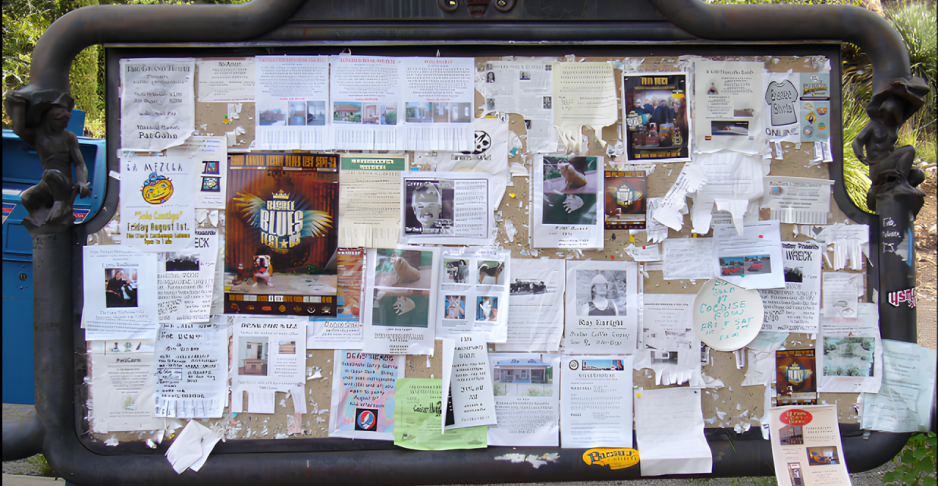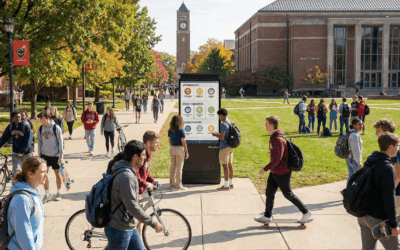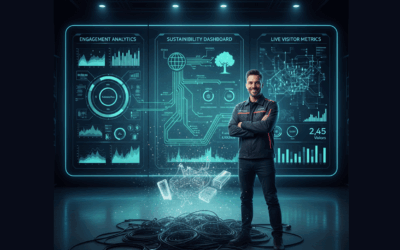Take a walk through any university hallway, dorm lounge, or student union, and you’ll see the same thing: corkboards, pinned flyers, half-torn posters, outdated event announcements, and overlapping messages vying for attention in a chaotic mess of paper.
It’s a campus tradition—and a communication relic.
The physical noticeboard has long been the go-to tool for student organizers, campus departments, and engagement teams trying to spread the word. But in today’s digital, fast-moving campus environment, this method is more than ineffective—it’s a waste of time, money, and opportunity.
In an era where students live by real-time notifications, short-form video, and mobile-first content, physical flyers simply don’t cut it anymore. What universities need is a modern communication infrastructure—one that’s dynamic, engaging, easy to manage, and always up to date.
That’s where interactive kiosks and digital signage platforms like HootBoard come in—offering a smarter, more sustainable way to engage students where they are.
The Decline of the Flyer
Let’s break down the many reasons traditional posters and noticeboards no longer serve their purpose.
1. Information Overload
Campus boards are often overwhelmed with dozens—sometimes hundreds—of flyers, creating a visual noise that students quickly learn to ignore. The more content you pin, the less likely it is that any one flyer will stand out.
2. Lack of Real-Time Relevance
By the time a flyer is printed, approved, and pinned:
- The event date may be too close
- The time or location might have changed
- The content may no longer be relevant
There’s no easy way to update or remove outdated information—leading to clutter and confusion.
3. Zero Analytics or Feedback
With a physical poster, you have no idea:
- Who saw it
- How many people engaged with it
- Whether it drove turnout
- What part of the message resonated
This makes it impossible to iterate, improve, or justify marketing spend.
4. Printing Costs & Manual Labor
Printing, cutting, taping, and posting flyers across campus may seem low-cost per unit—but at scale, it becomes a significant drain on resources:
- Paper and toner
- Design time
- Manual labor to distribute and remove outdated content
And it’s not environmentally friendly—flyers contribute to waste, especially when mass-printed for one-time events.
What Students Are Actually Paying Attention To
Today’s student generation is digitally native. They expect:
- Instant updates via push notifications or live feeds
- Visual content—videos, animations, motion graphics
- Personalization—location-based info that’s actually relevant
- Real-time access to events, updates, and services
They’re not stopping to read bulletin boards on their way to class. They’re scanning their phones, glancing at vibrant screens, and tapping through digital content that grabs their attention in the moment.
In short: the medium matters—and paper doesn’t align with modern student behavior.
The Smart Alternative: Interactive Kiosks
If traditional flyers are the old way of campus messaging, interactive kiosks are the new standard.
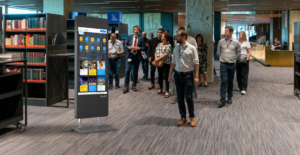
What is a Campus Kiosk?
An interactive kiosk is a digital display—touch-enabled or motion-based—placed in high-traffic areas like:
- Student unions
- Dormitory lobbies
- Libraries
- Dining halls
- Classroom buildings
Kiosks powered by HootBoard or similar platforms display real-time content like:
- Campus event listings
- Club meetings and signup forms
- Job fair schedules
- Student services info
- Emergency alerts
- Social initiatives and campaigns
They can be customized by department, updated remotely, and tailored by location or audience—making them a central hub for student communication.
Why Kiosks Outperform Flyers Every Time
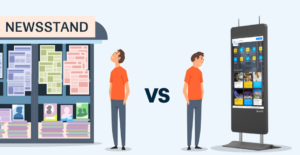
1. Real-Time Updates
Instead of waiting for a new flyer to be printed and posted, event organizers can update kiosks instantly with:
- Time changes
- Cancellations
- Reminders
- RSVP links
It’s communication in motion—not stuck to a wall.
2. Visual & Interactive
Unlike static posters, kiosks can:
- Rotate between multiple messages
- Use animation, video, or motion graphics
- Include QR codes for more info or sign-ups
- Let students interact with maps, directories, or surveys
The content isn’t just seen—it’s experienced.
3. Centralized Management
HootBoard’s platform lets university teams manage dozens of kiosks from one dashboard. Event organizers can:
- Schedule promotions
- Target content by kiosk location
- Assign posting permissions to specific clubs or departments
- Set expiration dates so content doesn’t become stale
No manual removals, no clutter, no forgotten flyers.
4. Measurable Impact
Unlike paper, kiosks give you analytics:
- Number of views per post
- Engagement interactions (taps, scans)
- Peak hours for foot traffic
- Most popular content types
This lets student affairs teams and event organizers measure effectiveness and continuously improve.
5. Sustainability & Cost Efficiency
While kiosks are an upfront investment, they:
- Eliminate ongoing printing costs
- Reduce paper waste
- Require no physical distribution
- Support multiple departments at once
Over time, they deliver higher ROI and lower environmental impact than printed communication.
Who Benefits from Going Digital?
🧑🎓 Clubs & Student Organizations
- Promote meetings and events
- Link to sign-up forms or social media
- Reach more students, faster
🧑🏫 Student Affairs Teams
- Share wellness resources
- Highlight involvement opportunities
- Run real-time campaigns (e.g., mental health week)
🎤 Event Planners
- Publish schedules, maps, and speaker lineups
- Post last-minute updates instantly
- Reduce no-shows and confusion
🛠️ Campus Facilities & Admins
- Announce maintenance schedules
- Direct students to alternate routes
- Display emergency notices
In all cases, kiosks offer more control, more visibility, and better outcomes.
The Real Cost of Staying Stuck in the Past

Let’s say a department prints 1,000 flyers per month at an average cost of ₹4 each (paper, printing, labor). That’s ₹48,000 per year—often for materials that are barely read, quickly outdated, and hard to measure.
Now compare that to a digital kiosk that:
- Replaces all of those flyers
- Supports multiple departments
- Offers real-time updates
- Lasts for years
- Delivers data and engagement metrics
The choice is clear.
Final Thoughts: A New Era of Student Communication
The campus noticeboard had its moment—but that moment has passed. Today’s students require faster, more engaging, more flexible communication channels that match how they live, move, and interact with content.
Interactive kiosks offer universities a future-ready way to:
- Improve visibility
- Streamline communication
- Boost event participation
- Reduce waste and cost
- Track results in real time
Don’t let your events, resources, or initiatives fade into the background. Bring your message to life—where students actually see it.

